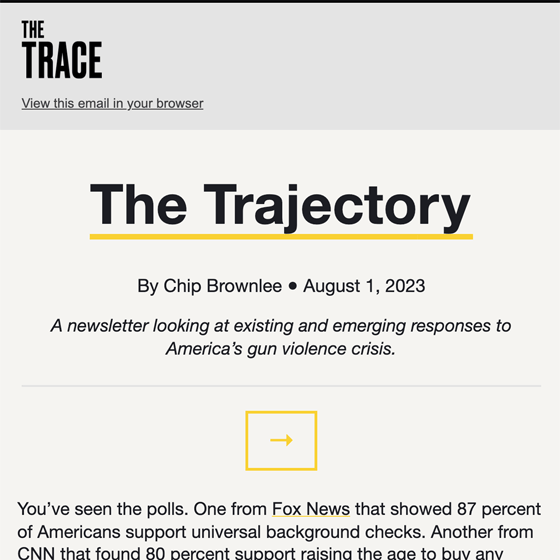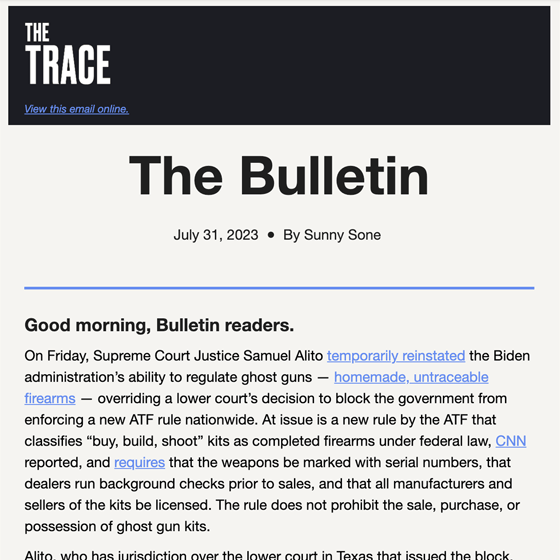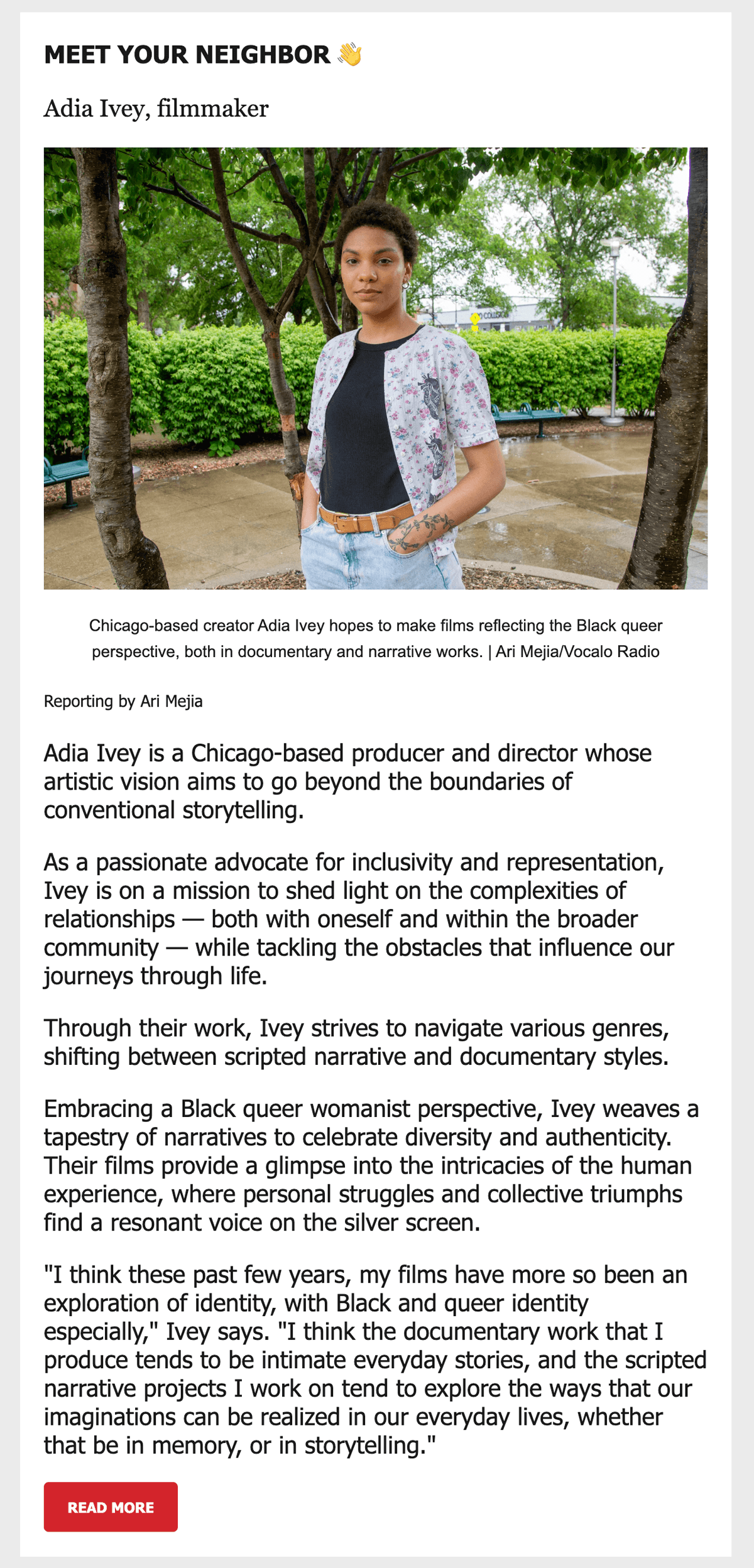Q & A: Sunny Sone, The Trace
Sunny Sone is one of my favorite journalists. I worked with Sunny when they interned at Austin Monitor, then later when they were Digital Editor for the Texas Observer. They are thoughtfully innovative, willing to experiment with new methods and formats to build new pathways between people and journalism.
Sunny Sone is currently Associate Newsletter Editor at The Trace, a nonprofit publication focused on gun violence.
I wanted to learn more about how The Trajectory, a new newsletter from The Trace, came about, how The Trace is approaching newsletters, and how Sunny thinks about the balance between qualitative and quantitative data.
We had a wonderful conversation. They share some great insights about the process of developing a new newsletter backed by audience research and the challenges of crafting successful products focused on a tough topic.
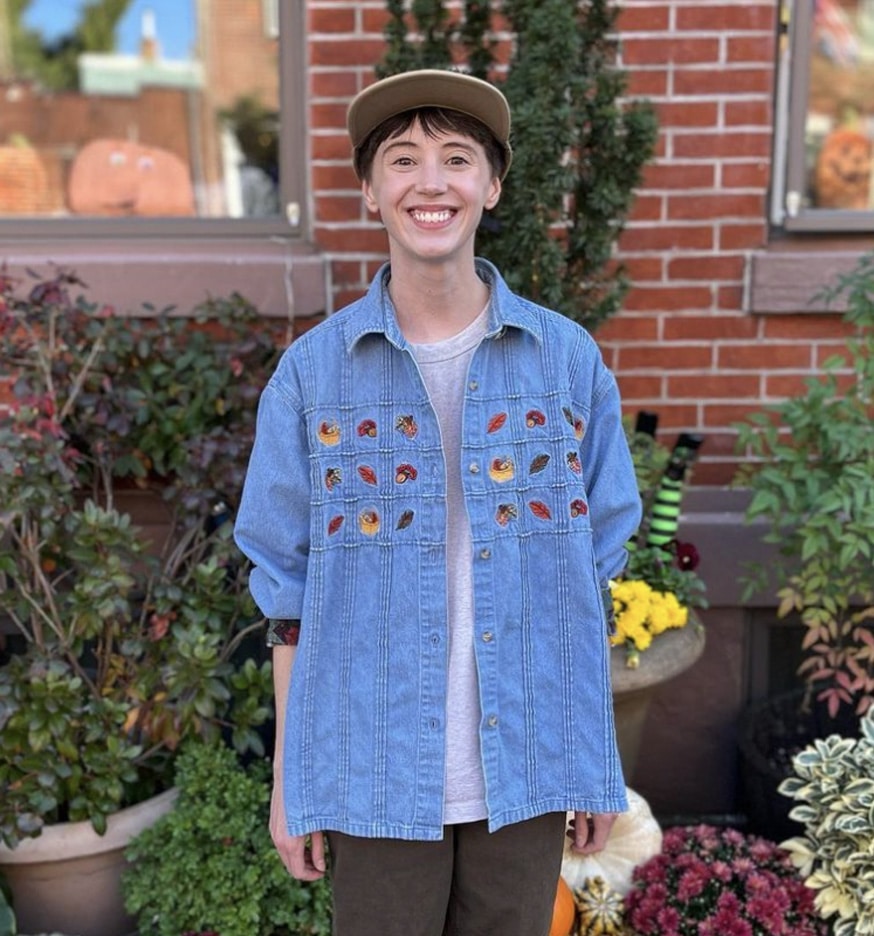
Meet Sunny Sone
Sunny Sone manages newsletters for The Trace. They previously worked as the digital editor for the Texas Observer, copy editor for The Intercept, and co-published Preachy, a digital zine under the Brick House cooperative.
Sunny is an alum of the University of Texas at Austin. They are currently based in Philadelphia (go Birds).
Cory Brown: Let’s talk about The Trajectory! It’s brand spanking new, right?
Sunny Sone: Relatively! There have been a few at this point. We sent the first edition at the end of May, right before Memorial Day, and it goes out every other week.
This Trajectory newsletter joins The Bulletin, The Weekly Bulletin, and newsletters for Philadelphia and Chicago.
The signup page says, “We’ll dive into the people, policies, and programs grappling with America’s gun violence problem.”
How does The Trajectory fit into your larger audience and editorial strategy?
At The Trace, we’re covering gun violence. It’s a grim subject. It is one that is pretty hard to read about a lot of the time. And one thing that we’ve tried to avoid is “if it bleeds, it leads” journalism.
We’re focused on gun violence, how gun violence fits into the political system, and what it looks like in a larger systemic way. We’re also looking at individual people. Essentially, we’re trying to look at this holistically. And so one thing that fits into that view is that there are people and programs working to curb gun violence. Those stories are something our audience has told us over and over again that they want to see more of. The Trajectory was born out of that.
I arrived at The Trace in September 2022. I conducted an audience survey about a month after I got there to take stock of where the newsletters were, and what our readers were interested in. One thing that came out of that survey was similar to something I heard during The Trace interview process. People are interested in research and what is being done to combat the crisis.
from the library
The Trace Trajectory Newsletter August 2023
See the full The Trajectory email and other daily newsletter examples in the 99 Newsletter Project Library.
We had a writer on staff, Chip Brownlee, who had been thinking about it already. There were plans a couple of years ago to try this sort of project. My understanding is that there wasn’t enough capacity among the staff at that time. After I came on board and we got the audience survey results, we dove in and spent a while developing the concept. Then we launched it this year.
What was the process for using the qualitative data from the audience surveys to pursue the idea that had been bouncing around before you got there?
The idea that had bubbled up, one that I had heard about when going through the interview process, was a solutions-focused newsletter. With the audience survey results, there was a clear interest in solutions, but there was also just as much interest in research.
Gun violence research is something that we don’t get to go in-depth on with our daily and weekly newsletters. The model for those is based around blurbs, so curious readers can follow links to read those stories or papers. But blurbs don’t provide as much context. For someone who might not have as much experience reading studies and interpreting the data, it’s going to be more difficult.
The idea here was to create a newsletter that is accessible to a general audience and examines these people, policies, and programs in a critical way.
You want to highlight the good, but you also want to understand the shortcomings. That way, you’re giving the audience insight into the complexities of the situation, what is realistic, and what work is already being done. That’s what often isn’t given as much attention.
These critical solutions-based stories are essential to The Trace’s mission of looking at the issue of gun violence holistically. The newsletter offers an opportunity to have a consistent output of this journalism that the readers have expressed that they really desire, that we think is often under-covered.
And so it evolved from a general solutions journalism idea, I’d say, to one more in line with the audience’s interests. This was also informed by what Chip was hoping to write, which was important because he was the one who was interested in doing this. He and I brainstormed a lot about the vision, and I think the fact that we spent so much time thinking about what this newsletter would look like paid off. I like The Trajectory. I love working on it. And I’m consistently in awe of Chip’s reporting and his ability to surface these stories.
Reading research papers is hard. Diving into the complexities of policy is hard. Being able to take all those and look at them and evaluate real-world trade-offs and drawbacks is hard. I think it’s fascinating that people want to help dive into this stuff, especially given the prevalence of distrust in the media.
What kind of insights can you share about the readers of The Trajectory and how they compare or contrast with readers of your other newsletters?
One thing I can say is The Bulletin, our Monday to Thursday newsletter, has a lot of .gov and .edu institutional email addresses on it. And The Trajectory has far fewer by comparison. It seems to be appealing to a more general audience. We’re about to do another audience survey, so we will have more insights there. Because it’s so nascent, I’m hesitant to say anything super declarative.
But yeah, it does seem different. One of our goals was to make The Trajectory accessible to an everyday reader who isn’t involved in the nitty-gritty of the gun violence issue. People who aren’t as familiar with the ins and outs. That seems to be what is happening.
Qualitative responses from readers who are actually reading your work are so informative. It’s important. If you want to know how your newsletter is doing, ask your readers.
Another thing that I should say is that because Chip was so behind this project, and we kind of wanted to have this general audience appeal, we prioritized making sure that Chip’s voice is really apparent in the newsletter. It’s not a column – and it’s not opinion – but we made it clear from the start that Chip would not be afraid to do analysis. So, the tone is friendlier, whereas the other two larger newsletters are very straight news for the most part. No analysis, just information.
Were there any outside inspirations or influences on how you approached The Trajectory?
I think one thing that you see in the structure of the newsletter is that we were — or at least I was — thinking about Substack. It wasn’t something we said directly, but if you look at the format, you can tell it was at least in the back of our minds.
I was also thinking about trust in the news, which is a big conversation right now. Trust was a driver in making sure that Chip’s voice was there, with this friendlier tone conveying, “We’re in this together.”
From looking at research and the success we’re seeing in other newsletters that are more personal, it appears that readers seem to be more inclined to trust information when they feel like they know the source that it’s coming from.
And I mean, from a personal standpoint, me too. If I’m reading something, I want to know everything about the writer.
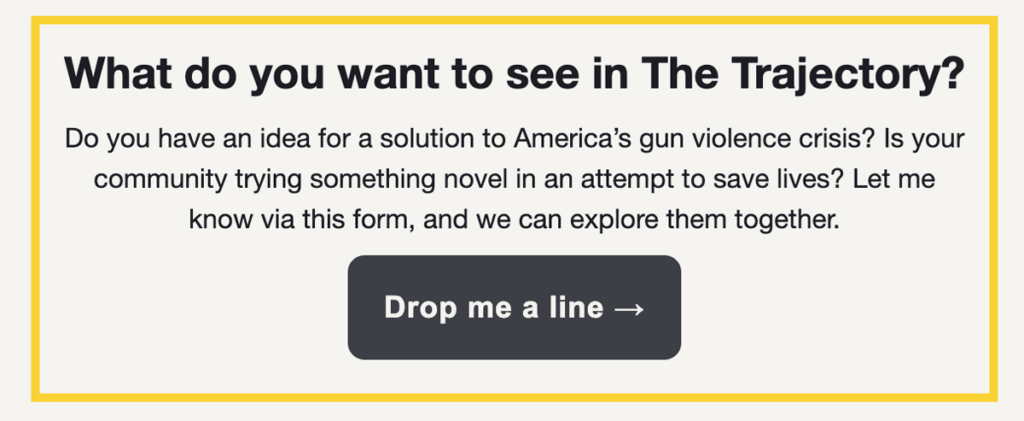
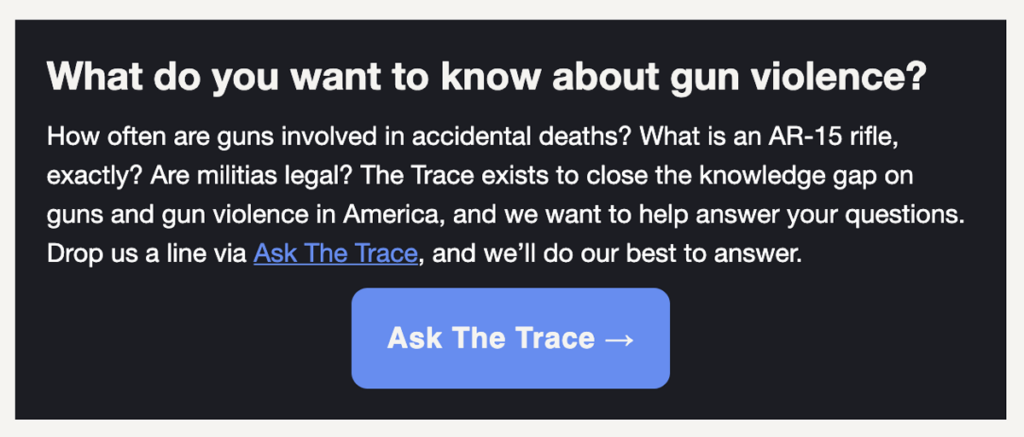
What’s been most surprising in the three months since The Trajectory launched?
I think the most surprising thing is that The Trace is a national publication, but it’s a single-issue nonprofit news outlet. We weren’t expecting The Trajectory to launch to great fanfare, but we got 300 subscribers, I think, before we even sent the first newsletter.
Then, it grew exponentially from there. People are opening the newsletter and reading it. More than half of the people on the list every time, and it continues to grow steadily. There was an initial burst in signups, and it has continued to climb steadily. It exceeded all our expectations in a way that was really affirming. We worked hard on The Trajectory. We thought about it a lot for months and months, and it’s good to see that kind of response.
That segues really well into: How are you evaluating success for The Trajectory?
Open rates are standard, so yeah, we’re looking at open rates. You kind of have to. We’ve been pleased by the metrics that we’re seeing so far. The “What do you want to see in The Trajectory” prompt has received really positive responses. People are sending in tips and saying — literally one person said — “This gives me hope.”
from the library
The Trace’s Daily Newsletter, The Bulletin
See the full The Bulletin email and other daily newsletter examples in the 99 Newsletter Project Library.
I’m also looking forward to the audience survey. One of the things that I believe, at my core, is that metrics can only tell you so much. You shouldn’t put all your eggs in that basket. Tech companies are kind of capricious, and gathering these metrics relies on so many different things. Qualitative responses from readers who are actually reading your work are so informative. It’s important. If you want to know how your newsletter is doing, ask your readers.
Not just The Trajectory but all The Trace emails seem to have multiple opportunities for readers to share feedback through direct asks. There’s a “what did you think of this” prompt, and there’s the Ask the Trace box where people can ask a question that they want answered.
As far as the intake and dealing with the information that comes in and processing that, how do you do that?
Ask the Trace, and most of our feedback forms are run through Airtable. Ask the Trace responses go to another editor because they form the basis of stories that reporters take on. The newsletter feedback form goes straight to me. Chip handles The Trajectory-specific tips, which I help manage as well.
It’s not a flood, but it is a pretty steady trickle. I just got two feedback responses today. I’d say that we get at least one to three a week from Bulletin or Briefing readers. It’s really helpful.
Sometimes a reader will tell you, “Hey, there was this story that maybe you missed,” or there will be tips. Sometimes there is positive feedback. Sometimes people will say, “This is propaganda.” We get those, too. I try to respond to everybody who sends feedback. Sometimes it takes a second. But it’s nice because it’s manageable.
Get the next Q&A as soon as it drops +
real newsletter breakdowns, step-by-step guides and more
What are some ways you’ve learned to translate that success to reporters so they can better understand how their work is consumed and then better reach and connect with readers?
I think the best example is probably the local newsletters. Our community engagement reporters for Philadelphia and Chicago, Afea Tucker and Justin Agrelo, write the local newsletters. The intention is for these local newsletters to reach local audiences. The way that we’ve tried to grow that list has been very intentional. For instance, Afea is at on-the-ground events in Philly, and she tells people about it.
I have translated metrics to make them useful for Afea and Justin. I tell them about open rates or unsubscribe rates, what they actually mean, and we talk about how to approach the newsletter. We talk about how their work can inform this local audience while trying to be careful and intentional. It’s an open conversation.
I have something that you wrote in an email thread that you and I and someone else was on. It was a million years ago; I think it was 2019. I still refer to this all the time.
The context of the conversation was around the growing use of data and analytics toward reader revenue and business side goals and how does that affect the relationship between the editorial and the business side? Because the business side can’t direct editorial. That’s not going to work.
You said, “Metrics can’t drive story production because story production is an art. You can inform people, but you can’t dictate. That’s how art dies.”
And I always loved that. There’s always a lot of focus on the logical, fact-based, information-driven aspect of journalism. That’s important, but telling a story is an act of art. It’s writing. There’s creativity involved. There’s a lot more involved than just writing down a bulleted list of facts and it’s the stories that make the reporting compelling a lot of the times.
Do you still believe that?
Yeah, I still believe that. What do metrics tell you about people? They can indicate things. They can suggest things. But I don’t think metrics can tell you a ton about people or art or the act of creation that connects with people. Yes, I still believe that.
How do you balance that with the reality of we need to measure things to at least have some idea of what’s happening? How do you balance collecting and observing the metrics without allowing them to dictate and kind of take the beauty out of the work?
You take kind of everything into consideration, right? You think about the numbers, and you collect them. You analyze what you can from them. You collect the qualitative data in a big way once a year, and in smaller ways the rest of the time.
Part of being in the world as a person is you are not going to always please everyone. People are going to be mad at some of the decisions that you make. Maybe those decisions were foolhardy. But maybe they turn out to be good decisions in the long run. That’s ultimately why we set these goals around mission and impact and reach, right, to see how we’re measuring up against them, to get an idea of what’s happening?
It’s important to pursue goals because your goals are related to your mission and your values. But when pursuing those goals, you can’t let open rate alone dictate how you’re doing.
It gets to the heart of this idea of: What is impact in journalism? Is it page views? Is it clicks? Is it the click rate in a newsletter? Is it likes on Twitter? Is it policy changes? Is it hearing from someone who read your story and shared that it changed their perspective? There’s an argument for all those things. I think it is an open and important debate about what to prioritize.
It’s my opinion that things on the ground are more important. But essentially what I’m thinking is you have to take it all into account, be flexible, and be understanding. You’re not going to be sure of everything all the time, and you’re going to piss people off, because that is the nature of being a person among other people.
What is a can you think of a small change that had a big impact to some of the success at The Trace?
This isn’t super small, but I’m a one-person newsletter team. I write the newsletters that go out every weekday. I edit the other newsletters, and I do strategy and other stuff. The Trace is a small newsroom. When I arrived, the daily newsletter took a long, long time to do.
After the audience survey, we started planning The Trajectory, but I also started working on a revamp of the then-weekday newsletter. Now it runs Monday through Thursday, and the format is different. It’s shorter because it was just taking up so much time. We made it easier to produce, but it’s also nicer for other people to fill in if I’m out.
It’s easier for the audience to read and understand what’s going on for the day, and look through to other things. We got a lot of positive feedback about the redesign, plus improved open and click rates. So it’s not a small change; it was a structural change.
What newsletters or publications do you look for for inspiration?
I really like the 19th newsletter. Here’s another that I’ve been thinking about so much lately. The Chicago Sun-Times’ afternoon newsletter is so good. It’s beautiful. And they have this section that’s called Meet Your Neighbor. I love that they highlight a neighbor, just saying, hey, meet your neighbor. I think that’s beautiful and it’s easy to read.
from the library
Chicago Sun-Times Afternoon Newsletter
See how the Meet Your Neighbor section fits into the the full Chicago Sun-Times Afternoon Newsletter and other examples in the 99 Newsletter Project Library.
I love that they are saying, “Hey, we’re the Chicago Sun-Times. We know you, you know us and this is a relationship.” I think it’s excellent.
The Marshall Project puts out a great daily newsletter. I really admire the news gathering they do. They find good stories that contextualize the biggest news of the day and then also things that you may not have seen before. When I think about my own news-gathering practices for the newsletters, I think of them as a model.
What is your most meaningful moment working at the Trace?
I have a few, but the week after The Trajectory launched and we saw the response. It was such an endeavor, so to see it resonate by all these different measures meant a lot. It was big for me, Chip, and Miles Kohrman, the editor who we worked with on this as well. It’s a good project. I really like it. I really like what it’s doing.
This Q&A was edited for length and clarity.
Get more expert insights for building
strong relationships with your audience in the 99 Newsletter Project newsletter:
You can opt-out at any time.
For more details, please review the Terms of service and Privacy Notice.

